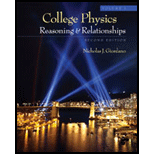
Concept explainers
(a)
The velocity of the object as a function of time.
(a)
Answer to Problem 36P
The velocity of the object as a function of time is
Explanation of Solution
Write the equation for the acceleration over a given time.
Here,
Conclusion:
Substitute
The velocity at
It is a constant acceleration of
Hence,
Therefore, write the velocity of the object as a function of time.
(b)
The velocities of the object.
(b)
Answer to Problem 36P
The new velocities of the object are
Explanation of Solution
The initial velocity here is
Conclusion:
Therefore, the new velocities are
And
Want to see more full solutions like this?
Chapter 2 Solutions
College Physics, Volume 1
- A car is traveling at an initial speed of 20 m/s and slows to rest with an acceleration of −5.0 m/s2. What is the stopping distance, in meters?arrow_forwardA woman backs her van out of her parking space with a constant acceleration of 1.8 m/s2. Assume that her initial motion is in the positive direction. Part A: How long does it take her to reach a speed of 2.1 m/s in seconds? Part B: If she then brakes to a stop in 0.65 s, what is her acceleration in meters per square second?arrow_forwardThe velocity vs time graph for an object is shown. How far has it gone in 4.5 seconds starting at t = 0s? The figure shows the velocity versus time graph for an object. From t = -3 to 0s, the velocity is constant at 45 m/s. From t=0 to 4.5s, velocity decreases linearly from 45 m/s to 0 m/s. 101 m 225 m 150 m 112 marrow_forward
- Figure P2.24 represents part of the performance data of a car owned by a proud physics student. (a) Calculate from the graph the total distance traveled. (b) What distance does tge car travel between the times t=10s and t=40s? (c) Draw a graph of its acceleration versus time between t=0 and t=50s. (d) Write an equation for x as a function of time for each phase of the motion, represented by (i) 0a, (ii) ab, (iii) bc. (e) What is the average velocity of the car between t=0 and t=50s?arrow_forwardThe acceleration of a crate sliding down a ramp is given by ax = (0.25t²) m/s² and ay = (1.5t³) m/s?, where t is in seconds. When t = Os, vx= 3 m/s and vy = 4 m/s. Determine the magnitude of the crate's velocity when t = 2 s.arrow_forward2.9 .. A ball moves in a straight line (the x-axis). The graph in Fig. E2.9 shows this ball's velocity as a function of time. (a) What are the ball's average speed and average velocity during the first 3.0 s? (b) Suppose that the ball moved in such a way that the graph seg- ment after 2.0 s was –3.0 m/s instead of +3.0 m/s. Find the ball's average speed and average velocity in this case.arrow_forward
- While entering a freeway, a car accelerates from rest at a rate of 2.81 m/s² for 13.3s. To help with this question, draw a sketch of the situation and list the knowns in this problem. a) How far does the car travel in those 13.3s? b) What is the car's final velocity? Submit answer Answers (in progress) Answer m m/s (3 4 Score -/0.5 -/0.5 0/1arrow_forwardA cat walks in a straight line, which we shall call the x-axis with the positive direction to the right. As an observant physicist, you make measurement of this cat's motion and construct a graph of the feline's velocity as a function of time. What distance (in cm) does the cat move from t=0 to t=7.5s?arrow_forwardAt time t = 0, a particle has a velocity of m v = 4.00. The following graph shows the particles a(t) S acceleration vs. time. a. What was the particle's velocity at t = 3.00s ? 2 4 t b. What was the particle's instantaneous acceleration time(s) at t = 3.00s ? С. What was the average acceleration between t = 1.00s and t = 3.00s ? 4- 2. acceleration(m/s)arrow_forward
- The elevators in the Landmark Tower in Yokohama, Japan are among the fastest in the world. They accelerate upward at 3.125 m/s^2 for 4.0 seconds to reach their final speed. if these elevators start from rest, what is their final speedarrow_forwardTraumatic brain injury such as concussion results when the head undergoes a very large acceleration. Generally, an acceleration less than 800 m/s2 lasting for any length of time will not cause injury, whereas an acceleration greater than 1 000 m/s2 lasting for at least 1 ms will cause injury. Suppose a small child rolls off a bed that is 0.40 m above the floor. If the floor is hardwood, the child’s head is brought to rest in approximately 2.0 mm. If the floor is carpeted, this stopping distance is increased to about 1.0 cm. Calculate the magnitude and duration of the deceleration in both cases, to determine the risk of injury. Assume the child remains horizontal during the fall to the floor. Note that a more complicated fall could result in a head velocity greater or less than the speed you calculate.arrow_forwardsketch a position vs time graph and a velocity vs time graph and an acceleration vs time graph. At time t = 0 you are walking in the positive x direction with a constant speed of 1 m/s. You maintain that speed for 6 s. Then, you decrease your speed uniformly to 0 over a 2 s interval. You rest for 2 s, then turn around and increase your speed uniformly to 2 m/s in 2 s. You continue at that speed until you return to the starting place.arrow_forward
 Principles of Physics: A Calculus-Based TextPhysicsISBN:9781133104261Author:Raymond A. Serway, John W. JewettPublisher:Cengage Learning
Principles of Physics: A Calculus-Based TextPhysicsISBN:9781133104261Author:Raymond A. Serway, John W. JewettPublisher:Cengage Learning
